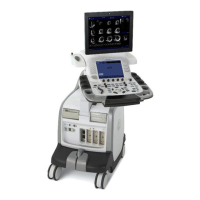GE H
EALTHCARE
D
IRECTION
GA091568, R
EVISION
5 VIVID E9 S
ERVICE
M
ANUAL
Chapter 4 - General procedures and Functional checks 4 - 41
4-3-4-4 Adjust the Color 2D Mode controls (cont’d)
Adjust the following settings to further optimize display of the image:
•Use Invert to reverse the color assignments in the color flow area of the display.
•Use Tissue priority to emphasize either the color flow overlay, or the underlying grey scale tissue
detail.
•Use Baseline to emphasize flow either toward or away from the probe.
•Use Radial and Lateral Averaging to reduce noise in the color flow area. Radial and Lateral
Averaging smooths the image by averaging collected data along the same horizontal line. An
increase of the lateral averaging will reduce noise, but this will also reduce the lateral resolution.
4-3-4-5 Select Color M Mode
1.) Select M Mode (See: 4-3-3 "M Mode Checks" on page 4-39).
2.) Use the trackball (assigned function: Pos) to position the ROI frame over the area to be examined.
3.) Press Select. The instruction Size should be highlighted in the trackball status bar.
NOTE: If the trackball control Pointer is selected, press trackball to be able to select between Position
and Size controls.
4.) Use the trackball to adjust the dimension of the ROI.
4-3-4-6 Adjust the Color M Mode controls
• Adjust the Active mode gain to set the gain in the color flow area.
•Adjust Scale to the highest setting that provides adequate flow detection.
NOTE: The scale value may affect FPS, Low Velocity Reject, and Sample Volume.
•Adjust Low Velocity Reject to remove low velocity blood flow and tissue movement that reduces
image quality.
•Adjust Variance to detect flow disturbances.
•Adjust Sample volume (SV) to a low setting for better flow resolution, or a higher setting to more
easily locate disturbed flows
•Adjust Frequency to optimize the color flow display. Higher settings improve resolution. Lower
settings improve depth penetration and sensitivity. This does not affect the frequency used for 2D
and M-Mode.
NOTE: NOTE: Frequency setting may affect FPS, SV and Low Velocity Reject.
•Adjust Power to obtain an acceptable image using the lowest setting possible.
NOTE: The Power setting affects all other operating modes.
Adjust the following settings to further optimize display of the image:
•Use Invert to reverse the color assignments in the color flow area of the display.
•Use Tissue priority to emphasize either the color flow overlay, or the underlying grey scale tissue
detail.
•Use Baseline to emphasize flow either toward or away from the probe.
•Use Radial and Lateral Averaging to reduce noise in the color flow area. Radial and Lateral
Averaging smooths the image by averaging collected data along the same horizontal line. An
increase of the lateral averaging will reduce noise, but this will also reduce the lateral resolution.

